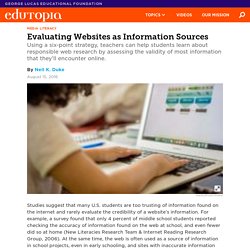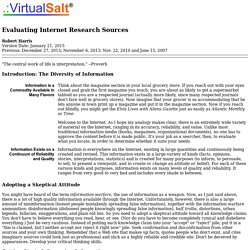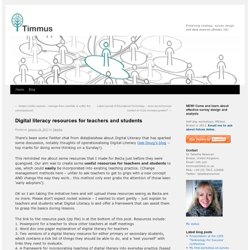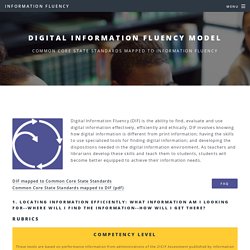

Stony Brook Center for News Literacy.
Civic Online Reasoning. Educational Leadership:Citizens in the Making:Teaching and Learning in a Post-Truth World. Mind Over Media: Analyzing Contemporary Propaganda. National Association for Media Literacy Education. ASCD Express 12.17 - The Critical Need for Critical Literacy. Evaluating Websites as Information Sources. Studies suggest that many U.S. students are too trusting of information found on the internet and rarely evaluate the credibility of a website’s information.

For example, a survey found that only 4 percent of middle school students reported checking the accuracy of information found on the web at school, and even fewer did so at home (New Literacies Research Team & Internet Reading Research Group, 2006). At the same time, the web is often used as a source of information in school projects, even in early schooling, and sites with inaccurate information can come up high in search rankings. Shenglan Zhang and I thought that we could help address this situation by laying a foundation for website evaluation in elementary school. In particular, we wanted to: To achieve these aims, we developed the WWWDOT Framework. Who wrote it and what credentials do they have? In teaching WWWDOT, we elaborate on each of these factors. In the study, the WWWDOT Framework was taught in four 30-minute sessions. Home. Evaluating Internet Research Sources. Robert Harris Version Date: January 21, 2015 Previous: December 27, 2013; November 6, 2013; Nov. 22, 2010 and June 15, 2007 "The central work of life is interpretation.

" --Proverb Introduction: The Diversity of Information Adopting a Skeptical Attitude You might have heard of the term information warfare, the use of information as a weapon. Getting Started: Screening Information Source Selection Tip: Try to select sources that offer as much of the following information as possible: Author's Name Author's Title or Position Author's Organizational Affiliation Date of Page Creation or Version Author's Contact Information Some of the Indicators of Information Quality (listed below) Evaluating Information: The Tests of Information Quality The CARS Checklist for Information Quality Summary of The CARS Checklist for Research Source Evaluation.
Digital literacy. Teaching Students Better Online Research Skills. Digital literacy resources for teachers and students. There’s been some Twitter chat from @dajbelshaw about Digital Literacy that has sparked some discussion, notably thoughts of operationalising Digital Literacy ( see Doug’s blog – top marks for doing some thinking on a Sunday!).

This reminded me about some resources that I made for Becta just before they were quangoed. Our aim was to create some useful resources for teachers and students to use, which could easily be incorporated into existing teaching practice. (Change management methods here – unfair to ask teachers to get to grips with a new concept AND change the way they work… this method only ever grabs the attention of those keen ‘early adopters’). OK so I am taking the initiative here and will upload these resources seeing as Becta are no more. Please don’t expect rocket science – I wanted to start gently – just explain to teachers and students what Digital Literacy is and offer a framework that can assist them to grasp the basics during lessons. Information fluency model. Digital Information Fluency (DIF) is the ability to find, evaluate and use digital information effectively, efficiently and ethically.

DIF involves knowing how digital information is different from print information; having the skills to use specialized tools for finding digital information; and developing the dispositions needed in the digital information environment. As teachers and librarians develop these skills and teach them to students, students will become better equipped to achieve their information needs. FAQDIF mapped to Common Core State Standards Common Core State Standards mapped to DIF (pdf) 1. Locating Information Efficiently: What Information Am I Looking For--Where Will I Find the Information--How Will I Get There? ALA 2011 - Why Transliteracy. The Essential Elements of Digital Literacies.